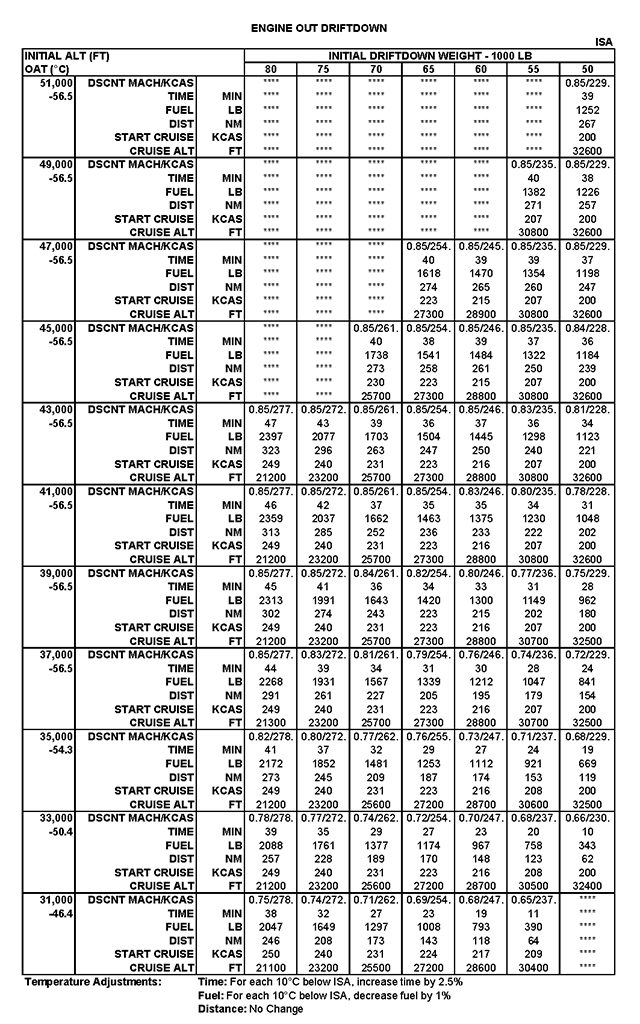G500 Drift Down
Updated: 2019-11-24
Keep in mind that the drift down procedure is designed to extract the maximum amount of forward distance from the airplane with an engine failed at high altitude, regardless of who is below you. If you are not alone in your block of airspace, does it really make sense to jeopardize the lives of hundreds of lives on a large airline passenger jet for the sake of the few siting behind you? On the other hand, if you can drift down safely, there are techniques to do this safely. Unlike previous Gulfstreams, the drift down charts are not where you suspect they are. Go to the Airplane Operating Manual, Performance section.
AOM Procedure
[AOM, §05-06-10, ¶1]
a. Drift down data are provided as a function of altitude and weight at the time of an engine failure. The drift down performance is shown for temperatures of ISA and ISA+20°C. For temperature less than ISA, temperature corrections are provided at the bottom of the ISA table.
b. Drift down Procedure
(1) To attain the drift down performance shown, the recommended drift down procedure described below must be followed.
(a) At the failure of one engine, Maximum Continuous Thrust is set and held on the operating engine during any deceleration, if required to reduce the speed to the entry descent Mach. Any deceleration should be performed at the initial altitude before the start of descent.
(b) The descent Mach number should be maintained until the calibrated speed is intercepted. The calibrated speed is then held down to the final drift down altitude (identified as “Cruise Altitude”).
(c) At the final drift down altitude, a 200 FPM rate of climb capability will be possible at Maximum Continuous Thrust at the “Start Cruise” Calibrated Airspeed shown. The “Start Cruise” Calibrated Airspeed shown is the single engine, Long Range Cruise speed at the final drift down altitude.
(d) Moderate thrust reductions are required at the “Cruise Altitude” to stabilize at the “Start Cruise” Calibrated Airspeed.
Technique
Photo: G500 Reference Stall Speed, AFM, §05-01-01, figure 12
Your first priority after an engine failure at high altitude is to keep the airplane flying. To do that you increase power on the operating engine while adding rudder to keep the airplane in coordinated flight. Disengaging the autothrottles and pushing the operating engine power lever full forward takes care of the thrust. You shouldn't need more than rudder trim to take care of the yaw.
The next decision is speed. How slow do you want to let the airplane decelerate before starting down. You obviously want to keep above stall speed, otherwise the flight control computers will take that decision from you. Stay above the yellow band, of course. How much room do you have? A lot:
Photo: G500 Engine Out Drift Down, AOM, §05-06-00, figure 1, sheet 1
Normal high altitude cruise speeds should normally be at least 0.85M which will give you 229 KCAS at FL450 on an ISA day. So you can get considerably slower. But should you?
As you can see from the Operating Manual engine-out drift down table, the optimal speed for drift down can be very near or even equal to your cruise speed. So if you want to extract as much forward distance as possible, you might need to start down immediately. But if you are in congested airspace, that might be the wrong decision. With your margin over stall speed, you can be assured that you don't have to fly the drift down speed immediately. Furthermore, you flight planning is probably based on an immediate descent to drift down altitude heading to your equal time point alternate. (You need to check with your flight planning service provider to be sure.)



